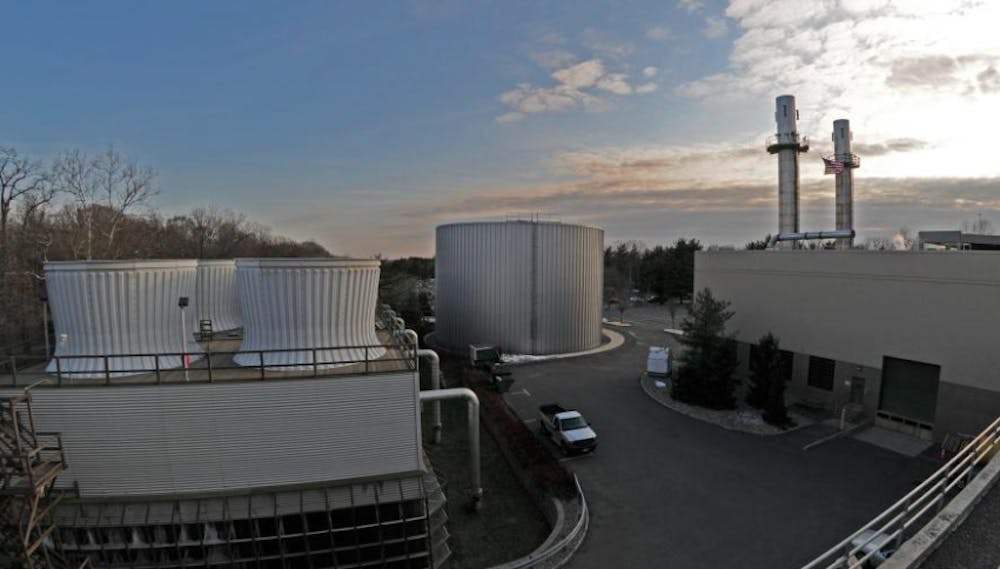On Wednesday, the Undergraduate Student Government’s Sustainability Task Force released a “Climate Progress Report,” summarizing the University’s carbon emissions trends since 1990, measures the task force and affiliated groups have implemented this year, and recommendations of personal sustainability for undergraduates.
The report comes on the heels of a proposed USG referendum that would establish a standing sustainability committee. Claire Wayner ’22, a co-author of the report and a Sustainability Task Force member, said she views getting the referendum on the ballot as the Sustainability Task Force’s single greatest accomplishment.
“I’m pretty hopeful and confident that we will permanently modify the USG constitution to include a standing sustainability committee,” she said. “This shows that sustainability is as important to the student body as academics and student life … [and] ensures that a sustainability chair will be included in conversations about planning events and other initiatives.”
Wayner, a columnist for The Daily Princetonian, published a column earlier this week advocating for a student “utilities” bill to discourage wasteful energy consumption.
The aim of the USG report is to share information discussed at the Princeton Student Climate Forum, held on campus in October 2019 and hosted by the Princeton Student Climate Initiative (PSCI), with the student body. In April 2019, PSCI passed a USG referendum with 95 percent voter approval, which called the University to undertake “swifter climate action.”
The report was compiled by Wayner and Amy Torres ’22 in collaboration with PSCI, USG, the Office of Sustainability, and the University’s Engineering and Campus Energy department.
Facilities Engineering reports that 2019 emissions were 12.8% higher than the 1990 baseline (largely due to severe cold snaps in recent winters), even with campus growth of 43 percent. Of these reported emissions, 67.9 percent comes from the energy plant’s burning of natural gas and heating oil, 1 percent from University transit vehicles (e.g. Tiger Transit buses), and 31 percent from electricity purchased from the local electric grid.
Currently, the University only tracks its Scope I and II GHG emissions, but the USG task force is actively working with the Office of Sustainability to begin tracking Scope III emissions as well.

The report enumerated the University’s emissions reduction goals. In 2008, the University adopted plans to reduce emission levels to their 1990 level by 2020. Ted Borer, the director of the University’s energy plant and one of the report’s contributors, wrote in an email to the ‘Prince’ he believes that though the University can meet this goal, it will “take a lot of work.”
“It will be a challenge, especially if we have an extremely cold winter or [an] extremely hot summer,” he explained. “For the past decade, we have been able to achieve a generally decreasing carbon footprint each year, even as the campus grew substantially. But the past two winters have included some unusually cold periods in which we had to burn a lot more fuel. This resulted in higher emissions than the previous winters.”
In 2017, the CO2 Task Force, a group of faculty and administrators, established an additional goal of reaching carbon neutrality by 2046.
Thus far, the University has invested $40.1 million toward building efficiency upgrades, including retrofitting over 102,000 lighting fixtures to LEDs, which cost $15.1 million and now saves 6080 metric tons (Mt) of CO2 per year.

The energy plant has also gone through an additional round of efficiency upgrades, which save 7160 Mt of CO2 per year, at a capital cost of $4.1 million. Lastly, the University has a 27 acre solar field, resulting in 3100 Mt of CO2 saved per year. The field provides up to five percent of the University’s total electricity demands.
In working towards 2046 carbon neutrality, the University aims to emphasize “reducing fossil fuel consumption in favor of renewable energy.”
Projects currently being started or planned in coming years include converting all buildings to a hot water heating system coupled with geothermal storage and electric heat pumps, installing an additional 13 MW of solar panels, investing $50 million over the next 10 years into more efficient heating/cooling systems in buildings, and purchasing off-campus renewable energy through the electric grid.
The final part of the report focused on what students can do to contribute to “reducing our campus energy usage.”
Recommendations included turning off the lights in spaces not in use, closing dorm windows when heating or air conditioning is on, unplugging chargers and personal appliances, washing clothing with cold water, air-drying clothing when possible, and reducing the number of appliances used (e.g. reconsidering whether a dorm room needs a mini-fridge).
The report also recommended setting rooms with thermostats to the “Tiger Zone,” which is 68°F in winter and 78°F in summer.
Wayner said the most important of these recommendations are those that relate to heating and cooling of spaces, because “that is the largest energy consumption [source] by far, as opposed to something like leaving an iPhone charger plugged in.”
As for communal spaces, the report recommended asking Facilities to turn the lights and heating off in rooms that are not being used and taking advantage of communal spaces for studying to reduce personal energy usage in dorm rooms.
“We’re asking students on campus to be the energy enforcers, monitors, eyes and ears, because Facilities can’t be at all places at all times,” Wayner added.
Thomas Nyquist, the University’s executive director of Engineering, encouraged students in an email statement to the ‘Prince’ to “call 609-258-5890 to report energy wasteful situations in University buildings.”
Borer wrote that one important recommendation missing from the report related to the environmental impact of students’ dietary choices.
“Choosing a plant-based diet or following a more plant-based diet will dramatically lower water use, land use, antibiotic use, carbon emissions, deforestation, and fossil fuel use,” he wrote. “It is something everyone has a choice about at every meal. It can be a very impactful change that does not need to cost any extra.”
Associate News Editor Linh Nguyen contributed reporting.








